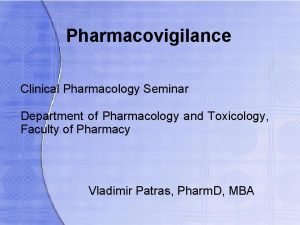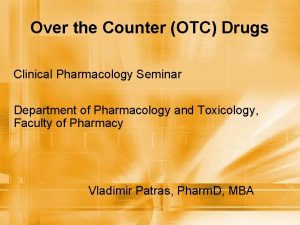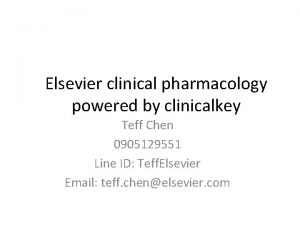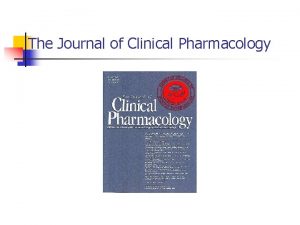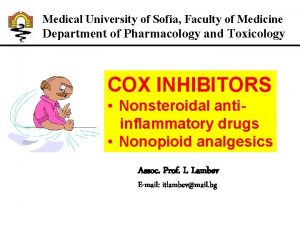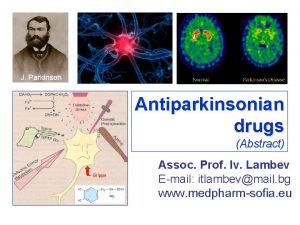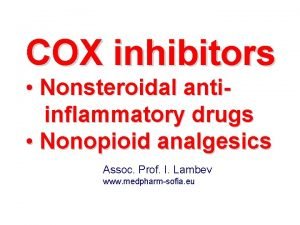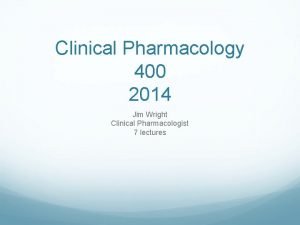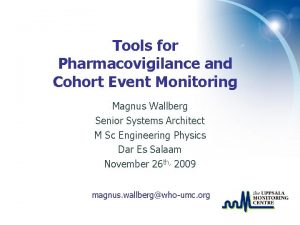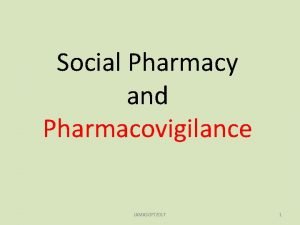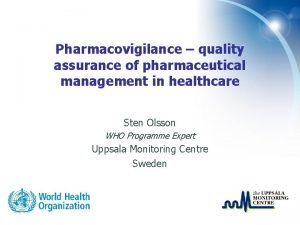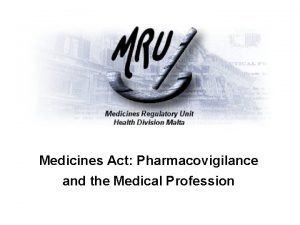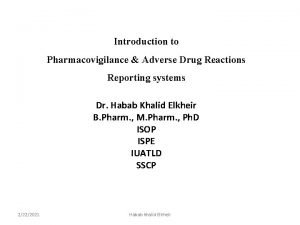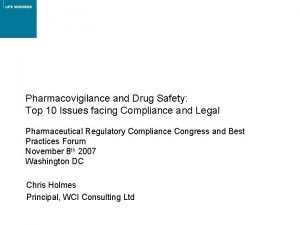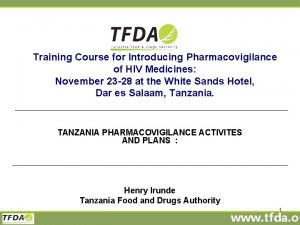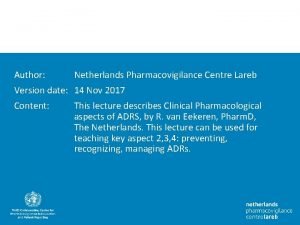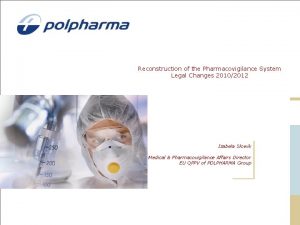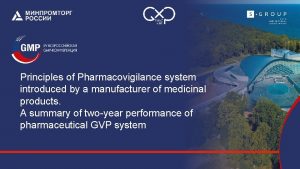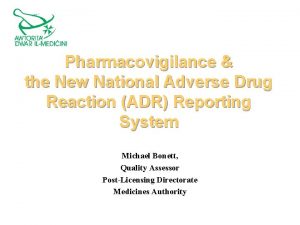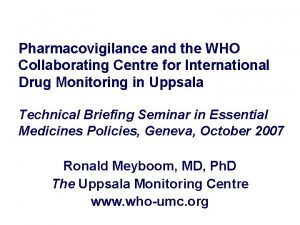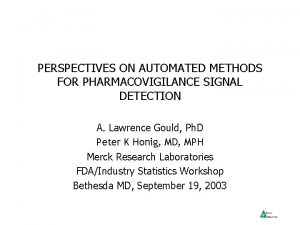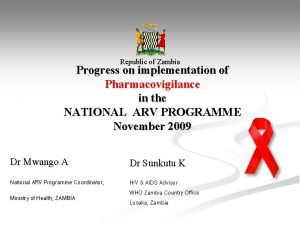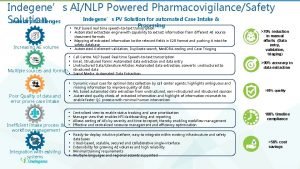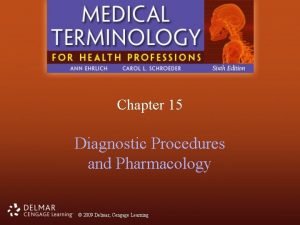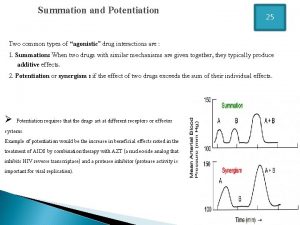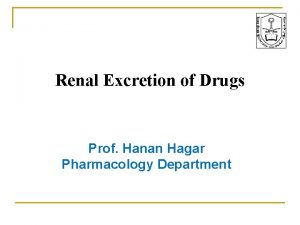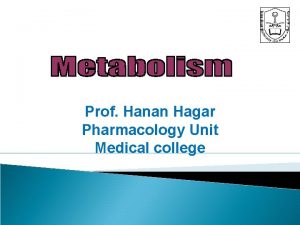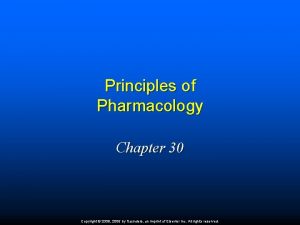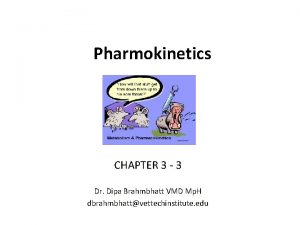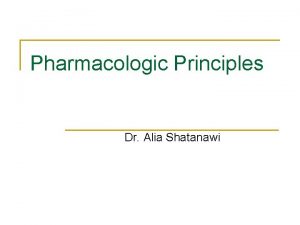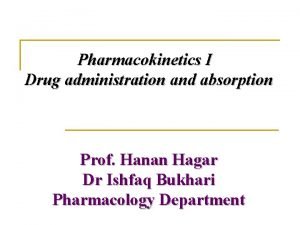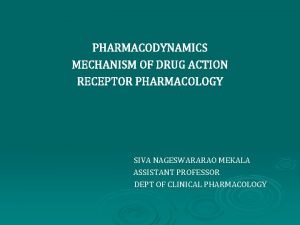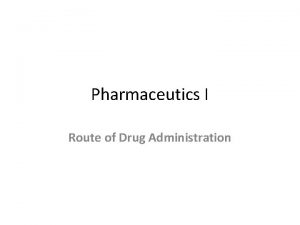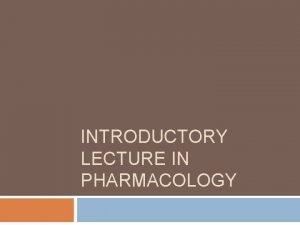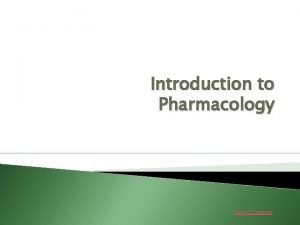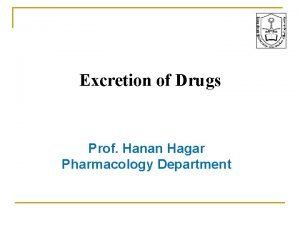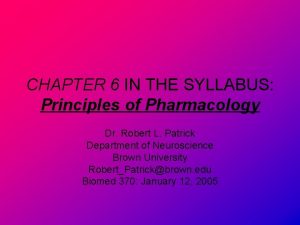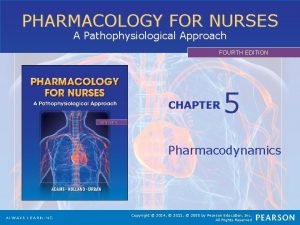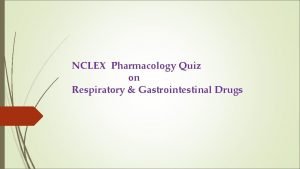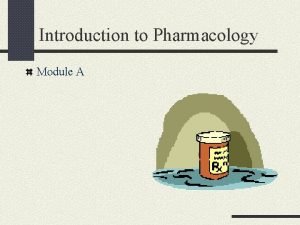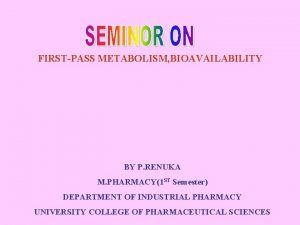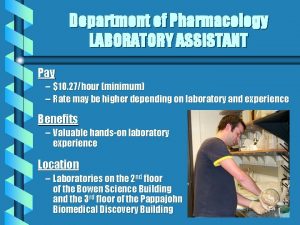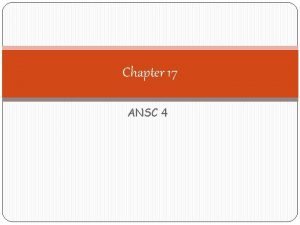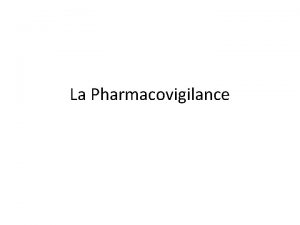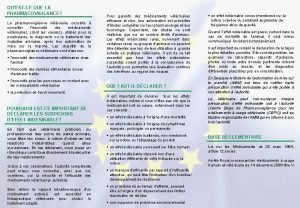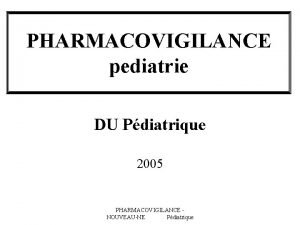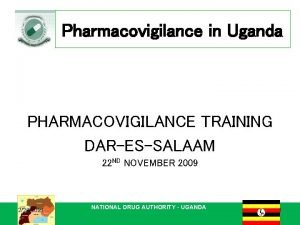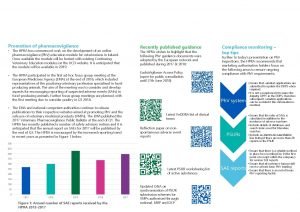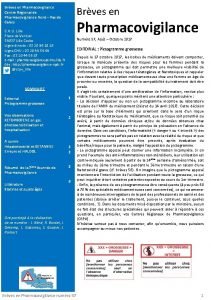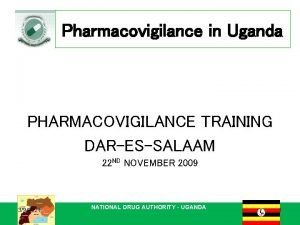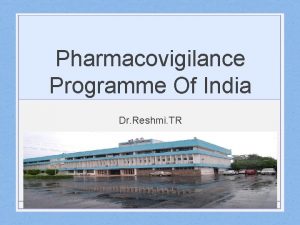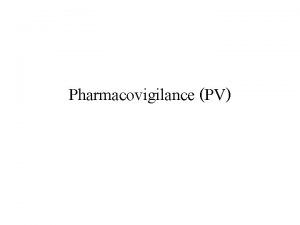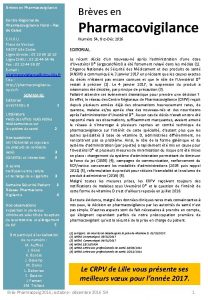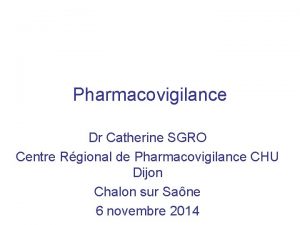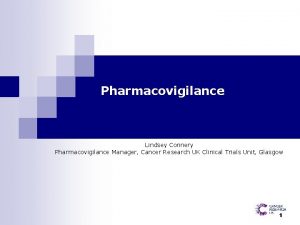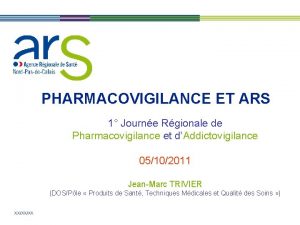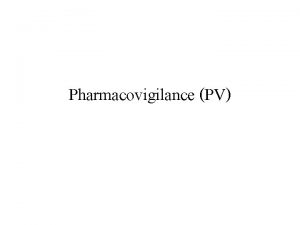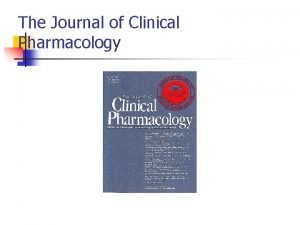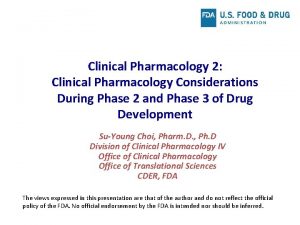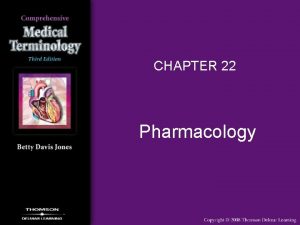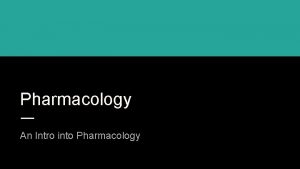Pharmacovigilance Clinical Pharmacology Seminar Department of Pharmacology and




















































- Slides: 52

Pharmacovigilance Clinical Pharmacology Seminar Department of Pharmacology and Toxicology, Faculty of Pharmacy Vladimir Patras, Pharm. D, MBA

Withdrawn Drugs (in the US, since 2000) Other drugs were restricted in use to exclude some patient populations or indications - Alosetron Some drugs were withdrawned and reintroduced after further studies or special safety measures – Natalizumab withdrawn in 2005 and reintroduced in 2006

Do you know ? Number of deaths resulting from medical errors in the US may be 100 000 per year. Medical errors are among leading causes of death (4 th - 6 th) – more prevalent then motor vehicle accidents. 5 % of all deaths may be caused by pharmaceuticals. Medical errors lead to excess costs ($ 37 B/year in the US), health injury Medical errors are preventable in large scale (at least in 50 %) but in some cases new approaches are needed

It should be recognized Each drug has its side effects Pharmacological/toxic effect frontier is only defined by dose quantity and may differ from patient to patient. Theoretically each drug can be toxic. There are efficient mechanisms how to tackle both expected and unexpected adverse drug reactions. Medicines safety is principal task of regulatory agencies.

What is Pharmacovigilance ? Data gathering related to the detection, assessment, understanding, and prevention of adverse events Identifying new information about hazards associated with medicines, preventing harm to patients Post-marketing surveillance (? ) Medical errors are broader category which includes adverse reactions but also other factors (diagnostic errors, equipment failure, nosocomial infections. . . )

Terms Adverse Event (AE) – any untoward medical occurrence that may present during treatment with a pharmaceutical product but which does not necessarily have a casual relationship with this treatment Adverse Drug Reaction (ADR) – a response to a drug which is noxious and unintended, and which occurs at doses normally used in man. Serious Adverse Event (SAE) – AE that is either lifethreatening, fatal, cause of prolong hospital admission, cause persistent disability or concern misuse or dependence

Terms Serious Adverse Drug Reaction (SADR) – ADR where SAE conditions of severity applies Unexpected Adverse Drug Reaction (UADR) – an adverse reaction, the nature or severity of which is not consistent with market authorization, or expected from the characteristics of the drug.

Terms Signal – reported information on a possible relationship between an adverse event and a drug, unknown or incompletely documented previously. Usually more than a single report is required to generate a signal, depending upon the seriousness of the event and the quality of the information

Expected and Unexpected Events Expected are those adverse events that were observed during clinical trials or post-approval observations and are mentioned in Summary of Product Characteristics (SPC) Unexpected are those adverse events that were not previously observed and are not documented (in SPC) Based on frequency of occurrence there are following categories of adverse events:

Avandia (Rosiglitazone) Adverse Reactions - SPC

Types of Adverse Reactions (Rawlins and Thompson Classification) Type A Effects (“Augmented”) Due to pharmacological effects Are dose related – may often be avoided by using doses which are appropriate to the individual patient Are common, can be experimentally reproduced, known before marketing Example: hypnotic effect after H 2 antihistaminics

Types of Adverse Reactions (Rawlins and Thompson Classification) Type B Effects (“Bizzard”, idiosyncratic reactions) Generally rare and unpredictable Little or no dose relationship, not related to drug pharmacodynamics Occur in predisposed, intolerant patients – can be explained by rare genetic polymorphism, allergic reactions Example: Penicilline allergies

Types of Adverse Reactions (Rawlins and Thompson Classification) Type C Effects (“Continuous”) Adverse reactions after long term therapy There is often no suggestive time relationship and the connection may be very difficult to prove. The use of a drug increases the frequency of “spontaneous” disease Example: carcinogenesis

Types of Adverse Reactions (Rawlins and Thompson Classification) Type D Effects (“Delayed”) Adverse effect may be presented years after a drug was used Example: Vagina cancer of daughters when their mother was treated by diethylstilbestrol Type E Effects (“Ending”) Absence of drug after withdrawal – rebound effect Example: corticosteroids in asthma treatment

Causality Assessment To determine likelihood of a causal relationship between drug exposure and adverse events it is necessary to evaluate Association in time/place between drug use and event Pharmacology (including current knowledge of nature and frequency of adverse reactions) Medical or pharmacological plausibility (signs and symptoms, tests, pathological findings, mechanism) Likelihood or exclusion of other causes (Case reports describe suspected ADRs)

Causality Assessment There are more assessment scales for causality evaluation which include: Karch and Lasagna scale Naranjo scale WHO probability scale Jones scale Karch and Lasagna Uses three categories of causality A – causality is highly probable B – not adequate proof of causality 0 – data are not adequate to assess causality

Causality Assessment

Classification of Adverse Events based on its severity Mild – no changes in therapy are needed Moderate – change of therapy is desired but the events are not life-threatening or causing disability Serious – is either life-threatening, fatal, cause of prolong hospital admission, cause persistent disability

Pharmacology in Adverse Reactions Detailed safety profile of a drug can only be evaluated and described on base of clinical research and postmarketing surveillance However, there are some factors that can be associated with higher safety risks. These risk can be on side of: Administered drug Patient Environment (xenobiotics, physical conditions) Higher safety risks are associated with medicines with no specific mechanism of action such as neuroleptics (haloperidol, chlorpromazine), non-selective cyclooxygenase inhibitors, cytostatics, morphine analgetics Another group is medicines with narrow therapeutic range (i. e. low therapeutic index) – cardiac glycosides, aminoglycoside antibiotics (gentamycin), theophylline Therapeutic index = Median Toxic Dose (TD 50)/ Median Effective Dose (ED 50)

Risks dependent on Patient Kidney insufficiency – failing excretion of drugs/active metabolites Liver disease – failing drug metabolism Polymorbidity – combination of factors such as drug interactions, multi-organ injury Immunocompetence – higher doses of some drugs (antibiotics) may be needed in decreased immune response New born age – drug metabolizing systems are not fully developed Allergies – risk of drug allergies is higher in patients with already suffer from another allergy Some specific diseases – such as contraindication of beta blockers in asthma

Pharmacogenetics Study of how individual`s genetic inheritance affects response to drugs Genetic polymorphisms in metabolizing enzymes can cause substantial differences in drug response. Some polymorphisms are very rare Genetic testing was developed to detect various polymorphisms in metabolizing enzymes (CYP 450) – this opens possibility of personalized prescribing to avoid adverse events Important enzymes in drug metabolism with more known polymorphisms Cytochrome P 450 polymorphisms – influence metabolism of various drugs Thiopurine Methyltransferase (TMT) – metabolism of thiopurines Acetyltransferases Another mechanism is interaction with Human Leukocyte Antigen system (HLA ) - klozapin, levamizol, carbamazepine

Risks dependent on Other Factors Drug dependent Drug interactions Environment dependent Xenobiotics (pesticides, veterinary antibiotics) can interact with drugs metabolism, most commonly on CYP 450 level

Classification of Adverse Events Adverse events can be roughly classified on base of its underlying mechanism, although this classification is not unambiguous and there are disputable cases to which category an event can be attributed Intolerance – lower then usual dose produce anticipated response Idiosyncratic (“unusual”) response – determined by genetic alteration, producing response that is not anticipated Allergy – response modulated by immune system Pseudoallergy – reaction similar to allergy but not mediated by immune system

System of Safety Data Gathering Clinical Trials Healthcare Professionals Pre-Approval Post-Approval National Regulatory Authority Patients Pharmaceutical Companies International Safety Databases

New Drug Approval Process Each new drug (New Chemical Entity, NCE) shall prove its safety and efficacy in order to gain marketing authorization Scientific data on efficacy/safety are collected in clinical trials If a drug meets all safety (and efficacy) requirements New Drug Application (NDA) is submitted to regulatory agency Regulatory agency reviews the application, may require further studies. It issues Marketing Authorization (MA) or reject application, guided by risk/benefit evaluation Research of drug safety continues after drug is introduced in clinical praxis as post-marketing surveillance (phase IV study)

Cerivastatin Case Study Cerivastatin was developed by Bayer to compete with other statins. Rhabdomyolysis cases were rare in other statins (3. 3 per 100 000 patientyears). Cerivastatin gained US marketing authorization in June 1997 as cholesterol lowering agent and cardiovascular disease prevention. It was introduced to US market in early 1998 under brand names Baycol and Lipobay. Soon after (until May 1998) Bayer received 6 SADRs of cerivastatin associated rhabdomyolysis in patients also taking gemfibrozil. This was followed by label update – rhabdomyolysis warning. First case of rhabdomyolysis associated with cerivastatin-gemfibrozil combination published in April 1999. July 1999 - Clinical trial of 1. 6 mg cerivastatin reveals high incidence of severe CK elevation (12 %) but the results are not published. Gemfibrozil-cerivastatin coprescription is contraindicated in December 1999

Cerivastatin Case Study By 2000, 549 cases of rhabdomyolysis associated with cerivastatin use has been reported to WHO Collaborating Centre in Uppsala Higher risk compared to other statins was admitted by Bayer in March 2000 Label update of April 2001 stated 0. 4 mg as starting dose (it became clear that higher doses are associated with higher elevated CK levels) That time Bayer performed study on the risk of myopathy. This study was later criticized because of its poor design but results has not been published. The final report was provided to the company in June 2001. Bayer voluntarily withdraws cerivastatin worldwide on August 8 th 2001 FDA publish research in 2002 which found mortality rates from rhabdomyolysis for cerivastatin users were 16 to 86 times higher than those of other statins. However, rhabdomyolysis asscociated with cerivastatin was found to be 270 cases per 100 000 patient-years (most cases were not fatal) in patients taking 0. 4 mg cerivastatin. Bayer faced approx. 8000 lawsuits in connection to Baycol/Lipobay

Who Regulates Drug Safety Slovakia – State Institute for Drug Control, Section of Drug Safety and Clinical Trials Czech Republic - State Institute for Drug Control, Pharmacovigilence department UK – Medicines and Healthcare Products Regulatory Agency, Vigilence Risk Management of Medicines USA – Food and Drug Administration, Center for Drug Evaluation and Research

International Cooperation in Drug Safety Eudra. Vigilence – data processing network for reporting and evaluating suspected adverse reactions of medicinal products in European Economic Area WHO Monitoring Centre in Uppsala Established in 1978 Coordination of the WHO programme for International Drug Monitoring Collection, processing of data, Education, Research

Sources of Information on Drug Safety Pre-clinical studies Clinical trials (pre- and post-marketing) Spontaneous adverse reaction reporting Epidemiological studies Data collected for other purposes Routine statistics Databases of prescription and outcomes

Pre-clinical Studies Standard toxicology pre-clinical tests are: Acute toxicity Repeat use toxicity Local irritation tests Pyrogenity Reproductive toxicity Mutagenity Carcinogenity

Clinical Trials Principal aim of clinical is to collect safety (and efficacy) data. The investigational drug shall prove safety profile consistent with human testing on base of pre-clinical studies. Clinical trials are subject of regulatory approval. The sponsor shall keep detailed records of all adverse events and he shall submit these records on request of regulatory authority. The sponsor shall ensure that all relevant information about suspected serious unexpected adverse reactions have to be recorded and reported to regulatory authority Other investigators participating in multicentric trials shall also be informed on serious unexpected adverse events

Clinical Trials Safety profile of investigational drug is described in Investigator`s Brochure (likewise SPC in marketed drugs Procedures for reporting of adverse events in clinical trials slightly differ from post-approval reporting. Standard are CIOMS forms, electronic reporting is now preferred Detailed guidance on the collection, verification and presentation of adverse reactions reports arising from clinical trials on medicinal products for human use, European Commission, April 2006 Serious events such as deaths are relatively rare and may present reason for termination of a clinical trial

Rationale for Post-Marketing Surveillance Tests in animals are insufficiency predictive of human safety In clinical trials patients are selected and limited in number Conditions of use in trials differ from those in clinical practice Duration of trials is limited Information about rare but serious adverse reactions, chronic toxicity, use in special groups such as children, the elderly or pregnant woman or drug interactions is often not available

Who Should Report Safety Data Physicians Pharmacists Pharmaceutical companies qualified persons – (Pharmacovigilence/Regulatory manager) Investigational products (clinical trials) Post-approval reporting – Individual Case Safety Report (ICSR), Periodic Safety Update Report (PSUR) In many countries patients are encouraged (but not obligated) to report side effects

What to Report – WHO recommendations Every single problem related to the use of a drug, because probably nobody else is collecting such information All suspected adverse reactions ADRs associated with radiology contrast media, vaccines, diagnostics, drugs used in traditional medicine, herbal remedies, cosmetics, medical devices and equipment Lack of efficacy and suspected pharmaceutical defects Counterfeit pharmaceuticals Development of resistance

What to Report (at least) Requirements for reporting differ from country to country. However, in each developed country healthcare professionals are legally obligated to report adverse reactions (although it is not always clearly stated which) It is important to report serious unexpected ADRs – those that are not described in SPC. Unexpected include also side effects mentioned in SPC when these occur in higher frequencies then described. Most cases of unexpected ADRs are associated with medicines newly introduced on the market It has no sense to report expected adverse In clinical praxis it is usually not easy to evaluate causality – report also in cases you are not sure about causal relationship Heathcare professionals may report adverse events also to marketing authorization holder for a medicine but are not obligated to

How to Report - Slovakia Guidance No. 15/2004 on reporting of side effects of registered medicines Form downloadable from SIDC site http: //www. sukl. sk Heathcare professional are obligated to report suspected adverse drug reactions with presumed casual relationship In 2004 there were about 900 reports mostly from physicians. Number of reports is significantly lower compared to other EU countries

How to Report - UK “Yellow. Card Scheme” - established in 1964 MHRA operates site http: //yellowcard. mhra. gov. uk/ for reporting of adverse drug reactions Reporting by post is also possible Both patients and healthcare professionals are encouraged to report all suspected adverse drug reaction. MHRA evaluates whether risk is serious and whethere is a causality. Pharmacies are encouraged to display poster on Yellow. Card and mention it to patients who may experience ADRs when giving advice MHRA provides yellow card to patients (distributed also thru pharmacies) with information on reporting. Pharmacists are considered to be crucial in informing patients on ADRs reporting

Content of Report (MHRA recommendations) The symptoms or a description of a side effect Information about the person who experienced the side effect (as a minimum, their initials, sex, and age at the time of side effect) The name of the medicine(s) thought to have caused the side effect The name and full address of the reporter so that the report can be acknowledged and contact made for further information, if neccessary.

Reporting Requirements for Marketing Authorization Holders (Pharmaceutical Companies) The Marketing Authorization Holder (MAH) should ensure that h has an appropriate system of pharmacovigilance in place in order to assume responsibility and liability for his products on the market and to ensure that appropriate action may be taken when necessary. MAH should therefore ensure that all information relevant to the risk-benefit balance of a medicinal product is reported to the Competent (Regulatory) Authorities and European Medicines Agency fully and promptly in accordance with the legislation Qualified Person Responsible for Pharmacovigilance MAH submit Periodic Safety Update Report (PSUR) for drugs marketed for less than five years. Submitted in 6 months intervals after MA, once per year two years after MA, then 3 -yearly intervals or upon request of regulatory authority Presentation, analysis and evaluation of new or changing safety data Sources of data include: spontaneous reports, scientific literature, warning received from other regulatory authorities worldwide, data from special registries, poison control centers and others

Safety Data Access http: //www. mhra. gov. uk/Safetyinformation/index. htm MHRA publish detailed report for most of registered drugs summarizing nature of adverse events

Regulatory Actions Safety warnings Labeling change/changes in SPC Withdrawal

Special Cases for Pharmacovigilence Some groups of medicinal products are not required to document their safety – natural medicines, homeopathic preparations Natural (herbal) medicines Exact composition is often not known, efficacy nor safety is usually not documented Marketing Authorization is granted on base of “traditional use” 37 ADR reports in Australia related to Echinacea use in allergy Homeopathic preparations Zycam Cold Remedy case – unusual dilution resulted in permanent loss of smell in several subjects and 340 filed and settled lawsuits Content of alcohol in some preparations for children is higher than allowed in allopathic medicines

Special Cases for Pharmacovigilence Medical Devices – regulated by State Institute for Drug Control. Slightly different reporting requirements – in competence of Medical devices department, particular reporting guidance Veterinary products – competent (regulatory) authority in Slovakia is Institute for State Control of Veterinary Biologicals and Medicaments based in Nitra. Veterinary legislation and marketing requirements are in many aspects similar to human medicines. EMEA is competent authority for veterinary products on European level. Nutritional Supplements – are considered to be special purpose nutrients. Basic safety but not efficacy proof is required for marketing authorization. Regulated in Slovakia by National Health Authority of the Slovak Republic (NHA SR). NHA SR regulates also cosmetic products

Disputable and Unresolved Issues Regulatory agencies are now under much more public attention they used to be ~10 years ago. Affairs such as Vioxx, Lipobay withdrawals attracted public attention and FDA criticism. FDA approach is considered to be more cautious now More stringent approach of regulatory bodies has not always been welcomed – there are claims that absence of some unapproved medicines on the market caused more harm then would be caused by its side effects Some countries lack recourses to establish pharmacovigilance systems. WHO provides some assistance in establishing pharmacovigilance systems in developing countries

How to Deal with Expected Adverse Reactions and Medical Errors Focus on medical errors has increased in recent Complex solutions and system approach New concepts of quality management in healthcare – application of knowledge from other industries It is expected that most errors are on level of diagnosis/prescribing and only about 15 % in dispensing of medicines

Potential Sources of Errors in Pharmaceutical Care Handwriting of prescriptions Prescribing doctors missing information on other prescriptions for a patient (drug interactions) Similar-sounding and look-alike names and packages of medication Level of stress on workplace Unclear records in information system Bad system of stock alignment/organization Disruptions in information availability and flow

Solutions It is expected that 50 – 75 % of medical errors are preventable Introduction of advanced medical information systems Electronic Health Record (EHR) Automatic checks for dose, interactions, allergies, resistance Personalized prescription (on base of pharmacogenetic data) Written procedures, quality management and safety audits Analyze all errors, research what enabled them Try to design uncomplicated processes

Personal responsibility (? ) Trial with Zheng Xiaoyu, former director of State Food and Drug Administration of China, Beijing Intermediate Court, May 29, 2007 Zheng Xiaoyu was convinced of taking bribes for enabling approval of unsafe medicinal products. He was executed on July 10, 2007

Where to find information Monographies/Compendia Davies: Textbook of adverse effects Dukes: Meyler`s side effects of drugs Journals Newsletters Regulatory Toxicology and Pharmacology Drug Safety Update – published by MHRA Regulatory Agencies FDA: http: //www. fda. gov/ EMEA: http: //www. emea. europa. eu/ SIDC: http: //www. sukl. sk

Thank You For Your Attention ! This presentation is published at http: //vpatras. blogspot. com You will find learning article on pharmacovigilance summarizing this seminar at the same site
 Clinical pharmacology seminar
Clinical pharmacology seminar Spremicides
Spremicides Clinical pharmacology powered by clinicalkey
Clinical pharmacology powered by clinicalkey Clinical pharmacology
Clinical pharmacology Basic & clinical pharmacology
Basic & clinical pharmacology Basic & clinical pharmacology
Basic & clinical pharmacology Chronic gout
Chronic gout Clinical pharmacology residency
Clinical pharmacology residency Cohort event monitoring in pharmacovigilance
Cohort event monitoring in pharmacovigilance Jamasoft
Jamasoft Pharmacovigilance quality assurance
Pharmacovigilance quality assurance Adrereport
Adrereport Define pharmacovigilance
Define pharmacovigilance Pvnet pharmacovigilance
Pvnet pharmacovigilance Cem stands for in pharmacovigilance
Cem stands for in pharmacovigilance Netherlands pharmacovigilance centre lareb
Netherlands pharmacovigilance centre lareb Solicited reports in pharmacovigilance
Solicited reports in pharmacovigilance Principles of pharmacovigilance
Principles of pharmacovigilance Objectives of pharmacovigilance
Objectives of pharmacovigilance International pharmacovigilance centre
International pharmacovigilance centre Pharmacovigilance signal detection methods
Pharmacovigilance signal detection methods Pharmacovigilance compliance
Pharmacovigilance compliance Application of pharmacovigilance in zambia
Application of pharmacovigilance in zambia Ainlp
Ainlp Pharmacovigilance kursus
Pharmacovigilance kursus Venipuncture for radiologic technologists
Venipuncture for radiologic technologists Chapter 15 diagnostic procedures and pharmacology
Chapter 15 diagnostic procedures and pharmacology Toxicology and applied pharmacology
Toxicology and applied pharmacology Annual review of pharmacology and toxicology
Annual review of pharmacology and toxicology Summation drug interaction
Summation drug interaction First order kinetics
First order kinetics What is ion trapping in pharmacology
What is ion trapping in pharmacology Hagar conjugation
Hagar conjugation Chapter 30 principles of pharmacology
Chapter 30 principles of pharmacology First pass metabolism
First pass metabolism Alia drug testing
Alia drug testing Summary of drug administration
Summary of drug administration Factors affecting absorption of drug
Factors affecting absorption of drug Mechanism of drug action
Mechanism of drug action First pass effect in pharmacology
First pass effect in pharmacology Alpha 1 vs alpha 2 receptors
Alpha 1 vs alpha 2 receptors What is pharmacology
What is pharmacology Pharmacology introduction
Pharmacology introduction Competitive antagonist
Competitive antagonist What is ion trapping in pharmacology
What is ion trapping in pharmacology Basic principles of pharmacology
Basic principles of pharmacology Pharmacology for nurses: a pathophysiological approach
Pharmacology for nurses: a pathophysiological approach Respiratory pharmacology quiz
Respiratory pharmacology quiz Pharmacology module
Pharmacology module First pass metabolism definition pharmacology
First pass metabolism definition pharmacology Pharmacology of drugs acting on respiratory system
Pharmacology of drugs acting on respiratory system Pharmacology pay
Pharmacology pay Ansc 497
Ansc 497
